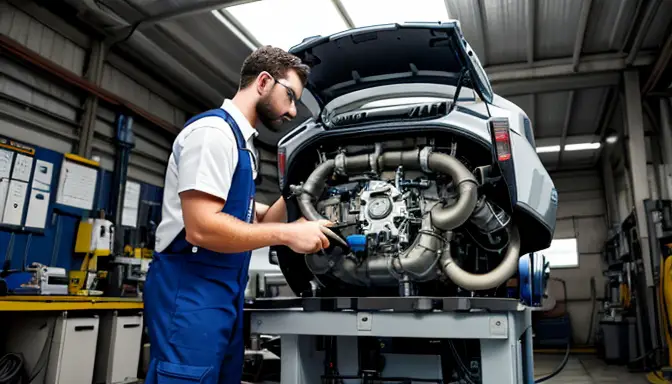When it comes to troubleshooting fuel pump problems in Volvo Penta engines, it’s essential to understand the key indicators and steps to diagnose and resolve issues effectively. Whether you’re experiencing engine sputtering, power loss, or starting difficulties, these symptoms can point to underlying fuel pump issues that need attention. By testing fuel pressure and inspecting fuel lines and filters for blockages or leaks, you can pinpoint the root cause of the problem and take appropriate action to restore optimal performance.
Regular maintenance practices play a crucial role in ensuring the health of the fuel pump in Volvo Penta engines. By following a set maintenance routine and keeping an eye on the fuel system components, you can prevent future problems and prolong the lifespan of the fuel pump. However, in cases where complex issues arise, consulting a professional mechanic is highly recommended to avoid further complications and ensure the proper functioning of the fuel pump.
Understanding the Fuel Pump in Volvo Penta Engines
When it comes to understanding the fuel pump in Volvo Penta engines, it’s essential to grasp its pivotal role in the operation of the entire system. Picture the fuel pump as the heart of the engine, responsible for pumping fuel from the tank to the engine cylinders with precision and efficiency. This component ensures that the engine receives the right amount of fuel at the correct pressure, crucial for smooth and powerful performance.
Let’s break it down further with a list:
- Fuel Delivery: The fuel pump is tasked with delivering fuel from the tank to the engine, maintaining a consistent flow to meet the engine’s demands.
- Pressure Regulation: It also regulates the pressure of the fuel to ensure optimal combustion within the engine, affecting performance and efficiency.
- System Integration: The fuel pump works in conjunction with other components like fuel lines, filters, and injectors to create a seamless fuel delivery system.
By understanding the fuel pump’s function in Volvo Penta engines, you gain insight into its significance and the potential impact it has on the engine’s overall performance and reliability.

Common Symptoms of Fuel Pump Problems
When it comes to Volvo Penta engines, recognizing the common symptoms of fuel pump problems is crucial in maintaining optimal performance. Here are some telltale signs that indicate potential issues with the fuel pump:
- Engine Sputtering: If your engine is sputtering or hesitating during acceleration, it could be a sign of fuel pump irregularities.
- Loss of Power: Experiencing a sudden loss of power while operating your Volvo Penta engine may point towards fuel pump issues.
- Difficulty Starting: Struggling to start the engine or frequent stalling could be attributed to fuel pump malfunctions affecting fuel delivery.
By being attentive to these common symptoms, you can proactively address fuel pump problems in Volvo Penta engines before they escalate into more severe issues, ensuring smooth sailing on the water.
Testing Fuel Pressure in Volvo Penta Engines
When it comes to testing fuel pressure in Volvo Penta engines, accuracy and precision are key. To ensure your engine is running smoothly, follow these steps:
- Start by locating the fuel pressure test port on the engine. This port is typically found near the fuel rail or the fuel filter.
- Attach a fuel pressure gauge to the test port and secure it tightly to prevent any leaks during testing.
- Turn the ignition key to the “On” position without starting the engine. This will pressurize the fuel system and allow you to take an initial reading on the gauge.
- Observe the fuel pressure reading on the gauge. Compare this reading to the manufacturer’s specifications for your specific Volvo Penta engine model.
- If the fuel pressure is below the recommended range, it may indicate a problem with the fuel pump or a clogged fuel filter.
- Perform a leak-down test to check for any pressure drops, which could signal a faulty fuel pump or a leak in the system.
Inspecting Fuel Lines and Filters
When inspecting the fuel lines and filters in your Volvo Penta engine, it is crucial to pay attention to various key aspects to ensure optimal performance. Start by visually examining the fuel lines for any signs of wear, cracks, or leaks that could lead to fuel leakage or pressure loss. Additionally, check the fuel filters for clogs or contaminants that may be restricting the flow of fuel to the engine.
Utilizing a systematic approach, follow these steps to thoroughly inspect the fuel lines and filters:
- Inspect the fuel lines from the fuel tank to the engine for any physical damage or deterioration.
- Check the connections between the fuel lines and filters to ensure they are secure and free from any leaks.
- Examine the fuel filters for any debris, sediment, or buildup that could impede fuel flow.
- Consider using a fuel pressure gauge to measure the pressure in the fuel lines before and after the filters to identify any significant discrepancies.
By diligently examining and maintaining the fuel lines and filters, you can prevent potential issues that may affect the performance of the fuel pump in your Volvo Penta engine, ultimately ensuring smooth operation on the water.
Repairing or Replacing the Fuel Pump
When it comes to repairing or replacing the fuel pump in Volvo Penta engines, it’s crucial to follow a systematic approach to ensure the job is done effectively. Here are some key steps to consider:
- Diagnosis: Begin by accurately diagnosing the issue with the fuel pump to determine whether repair or replacement is necessary.
- Accessing the Fuel Pump: Locate the fuel pump in the engine compartment and ensure you have the necessary tools for the job.
- Disconnecting the Power Source: Before any work begins, disconnect the power source to prevent any accidents or mishaps.
- Removing the Old Pump: Carefully remove the old fuel pump, taking note of its position and connections for the replacement process.
- Installing the New Pump: Install the new fuel pump securely, ensuring all connections are tight and secure to prevent any leaks.
- Testing the System: After installation, test the fuel pump to ensure it is functioning correctly and there are no issues.
Proper Maintenance Practices for Fuel Pump Health
Proper maintenance practices are crucial for ensuring the longevity and efficiency of the fuel pump in Volvo Penta engines. By following a few simple steps regularly, you can keep your fuel pump in optimal condition and prevent potential issues down the line. Here are some key maintenance practices to prioritize:
- Regular Inspections: Perform visual inspections of the fuel pump, fuel lines, and filters to check for any signs of wear, damage, or leaks. Addressing minor issues early can prevent them from escalating into major problems.
- Use High-Quality Fuel: Ensure that you use clean and high-quality fuel to prevent contaminants from clogging the fuel pump or causing damage to its components.
- Replace Fuel Filters: Regularly replace fuel filters according to the manufacturer’s recommendations to maintain proper fuel flow and prevent blockages that can strain the fuel pump.
- Monitor Fuel Pressure: Periodically test the fuel pressure to ensure that the fuel pump is delivering fuel at the correct pressure levels. Any deviations could indicate underlying issues.
- Keep Fuel System Clean: Avoid letting debris or dirt accumulate in the fuel tank or fuel lines, as this can impact the fuel pump’s performance. Regularly clean the fuel system to prevent buildup.

Consulting a Professional Mechanic
When facing complex fuel pump problems in Volvo Penta engines that go beyond simple DIY solutions, is crucial. These experts possess the knowledge and experience to accurately diagnose and address intricate issues that may be affecting the fuel pump’s performance. By seeking professional assistance, you can ensure that the problem is properly identified and resolved, preventing further damage to your engine.
Here are some reasons why is the best course of action:
- Expertise in Volvo Penta engines and fuel system components
- Access to specialized tools and diagnostic equipment
- Ability to perform in-depth inspections and tests
- Experience in repairing or replacing fuel pumps efficiently
By entrusting your Volvo Penta engine to a skilled mechanic, you can rest assured that the fuel pump problems will be addressed effectively, restoring your engine’s performance and reliability.
Frequently Asked Questions
- What are the common symptoms of fuel pump problems in Volvo Penta engines?
Common symptoms include engine sputtering, loss of power, and difficulty starting, indicating potential fuel pump issues.
- How can I test fuel pressure in Volvo Penta engines?
Follow step-by-step instructions to test fuel pressure and determine if the fuel pump is operating within correct parameters.
- What maintenance practices can help keep the fuel pump in Volvo Penta engines healthy?
Regular maintenance routines are key to ensuring the fuel pump’s good condition and preventing future problems.
- When should I consult a professional mechanic for fuel pump issues?
It is important to seek expert help when facing complex fuel pump problems beyond what DIY solutions can handle.
- What Happened to Bluewater Yachts? The Inside Story - May 31, 2024
- Upgrade Your Boat’s Water Pump to the Mach 5 - May 30, 2024
- Upgrade Your Boat with the Big Stuff Stuffing Box - May 30, 2024


